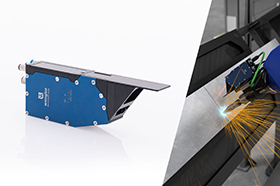2D/3D profile sensor for weld seam tracking
July 2022
Sensors & Transducers

Automated weld seam tracking in robot welding cells is a complex task in a harsh industrial environment. The micrometre-accurate detection of the guide point with different types of joint by 2D/3D profile is one of the most effective solutions for this challenge.
In combination with Wenglor’s uniVision software, the new weCat3D MLZL 2D/3D profile sensor not only combines the necessary precision and profile quality (1280 points per profile), but also offers convenient installation, integration, robustness and user-friendliness. The working range is from 74 to 158 mm and the measuring range on the X axis is 39 to 62 mm.
The slimline housing of the MLZL – with integrated cooling and rinsing – enables easy, space-saving installation directly on the welding torch. With dimensions of only 33 x 183 x 69,8 mm, the robot can also operate in narrow corners. The sensor does not require any additional protection housing thanks to its IP67 rating, nor does it need to be tilted for alignment. The design also offers sufficient protection against welding splatter and disturbing ambient light.
Optionally equipped with a red or blue laser, users can choose between three laser classes: 2M, 3R or 3B. The MLZL relies on the advanced laser technology of the weCat3D series from Wenglor to deliver optimal profile quality and seam tracking.
uniVision 2.5.0 for welding applications
The standard configuration software uniVision now incorporates a standalone module specifically for weld seam tracking, helping to get welding applications set up in just a few clicks. Due to the robust algorithms, tracking points can be determined reliably even in the event of faults in the joint course, such as with datum points. Predefined templates, where all common joint types are saved, significantly reduce the configuration work. The result can be visualised in a web browser, with several interfaces available for direct integration into robot controls from Kuka, Fanuc, ABB, Kawasaki and Yaskawa.
uniVision software is used to analyse images and height profiles in the field of industrial image processing. Two- and three-dimensional data from smart cameras, vision systems, smart 2D/3D profile sensors and industrial PCs with 2D/3D profile sensors can also be evaluated. In total, up to 25 different software modules and various templates are available to users, depending on the selected hardware.
The new combination of software and hardware offers flexible solutions for every user. The most convenient and comprehensive system consists of a sensor, control unit with pre-installed uniVision software application, and optional robot interface. There are also other combinations, with or without a control unit and/or customer-specific integration software, which translates to Wenglor being able to offer the right solution to suit every individual requirement.
Further reading:
Miniature inductive sensors
ifm - South Africa
Sensors & Transducers
The inductive IY/IZ type sensors from ifm are used in various industrial areas where space is limited.
Read more...
The expanding role of 3D cameras in industrial quality control
TANDM Technologies
Sensors & Transducers
Across factory floors, warehouses, mines and research centres worldwide, computer vision paired with 3D camera technology is revolutionising quality control.
Read more...
PDS implementation on mines
Sensors & Transducers
Level 9 vehicle intervention for collision avoidance has been mandatory on South African mines since 2022, yet the effective roll-out of proximity detection systems remains slower than expected. This is not due to the technical limitations of integration but to operational readiness on site.
Read more...
Monitoring analogue process values
ifm - South Africa
Sensors & Transducers
Everywhere in industry, electronic sensors are used to detect process values such as temperature, pressure or flow. Process value monitoring often takes place directly in the sensor.
Read more...
Protecting buildings’ embodied carbon with retrofitted systems
Schneider Electric South Africa
Sensors & Transducers
The World Economic Forum has said that around 80% of the buildings in existence will still be around in 2050; it is therefore essential that in order to combat climate change we retrofit them for energy efficiency.
Read more...
Listening for damage to wind turbines
Sensors & Transducers
The Fraunhofer Institute for Integrated Circuits, working in concert with the Fraunhofer Institute for Wind Energy Systems, has developed a solution that can be used to identify cracks and breakage inside wind turbine blades remotely at an early stage.
Read more...
Enhancing gold leaching efficiency
Endress+Hauser South Africa
Sensors & Transducers
Endress+Hauser offers a range of advanced technologies designed to enhance the stability and accuracy of pH and dissolved oxygen measurements on gold processing plants.
Read more...
Powering safer mining with PDS
Sensors & Transducers
With the mining industry under increasing pressure to prioritise safety without compromising productivity, Booyco Electronics is pushing the boundaries of Proximity Detection System and Collision Avoidance System technology across both underground and surface operations.
Read more...
The car of the future listens
Sensors & Transducers
The perception of external sounds in cars has been lacking, even in automated driving. That is why Fraunhofer IDMT-HSA is researching the integration of acoustic sensor technology in its KI4BoardNet project with the Hearing Car.
Read more...
Telco Sensors for blocked or empty chute detection
Sensors & Transducers
In most industries there is a problem with photoelectric sensors as highly contaminated environments make it difficult to operate and sense reliably. Telco Sensors overcomes this through its powerful high-performance infrared sensors that ensure penetration of harsh pollution to guarantee reliable detection.
Read more...


